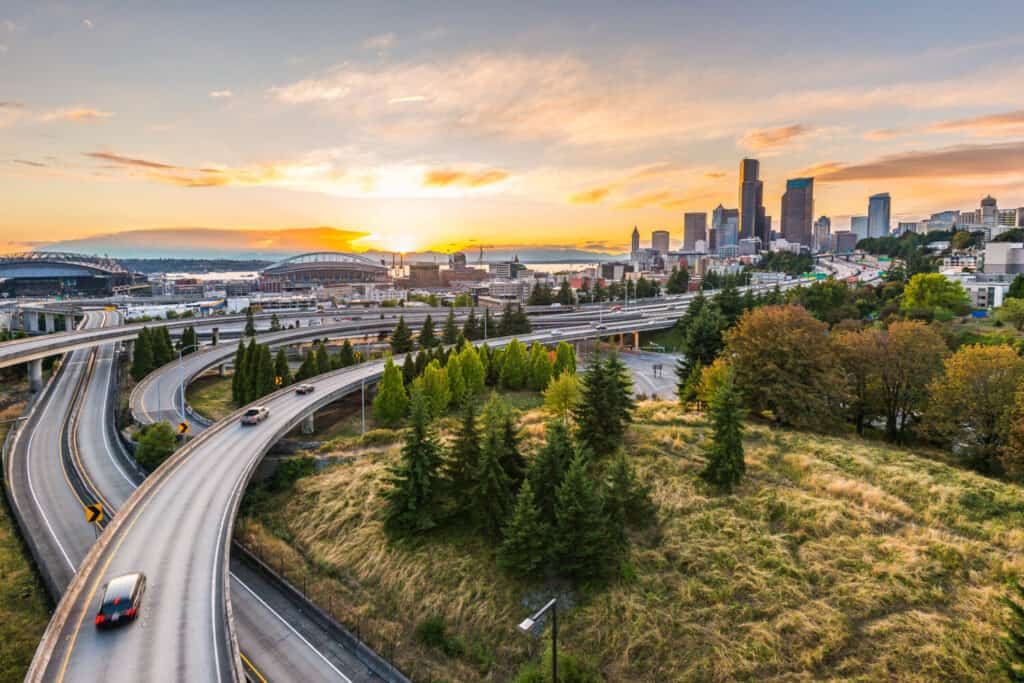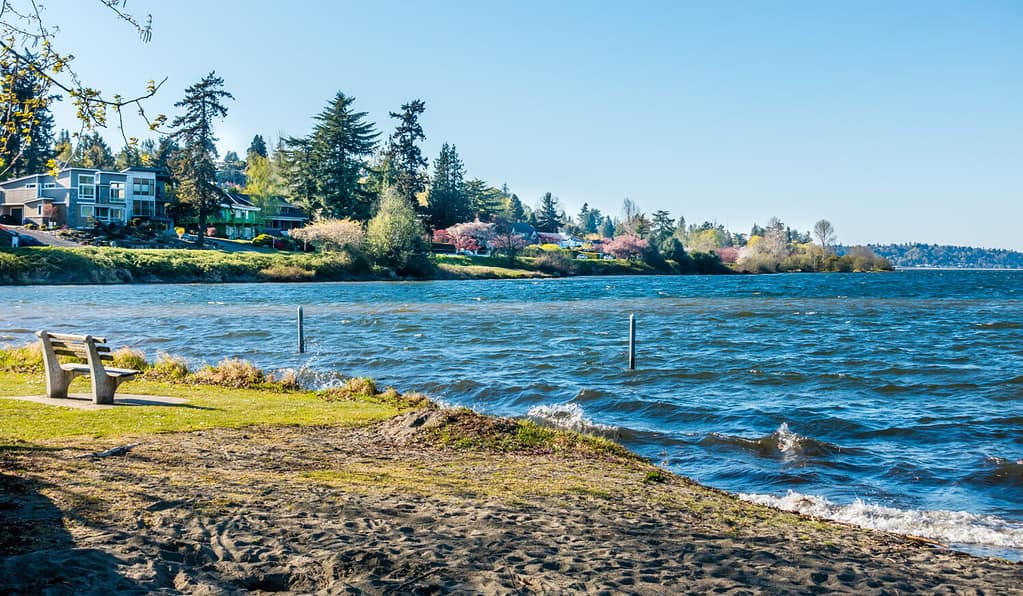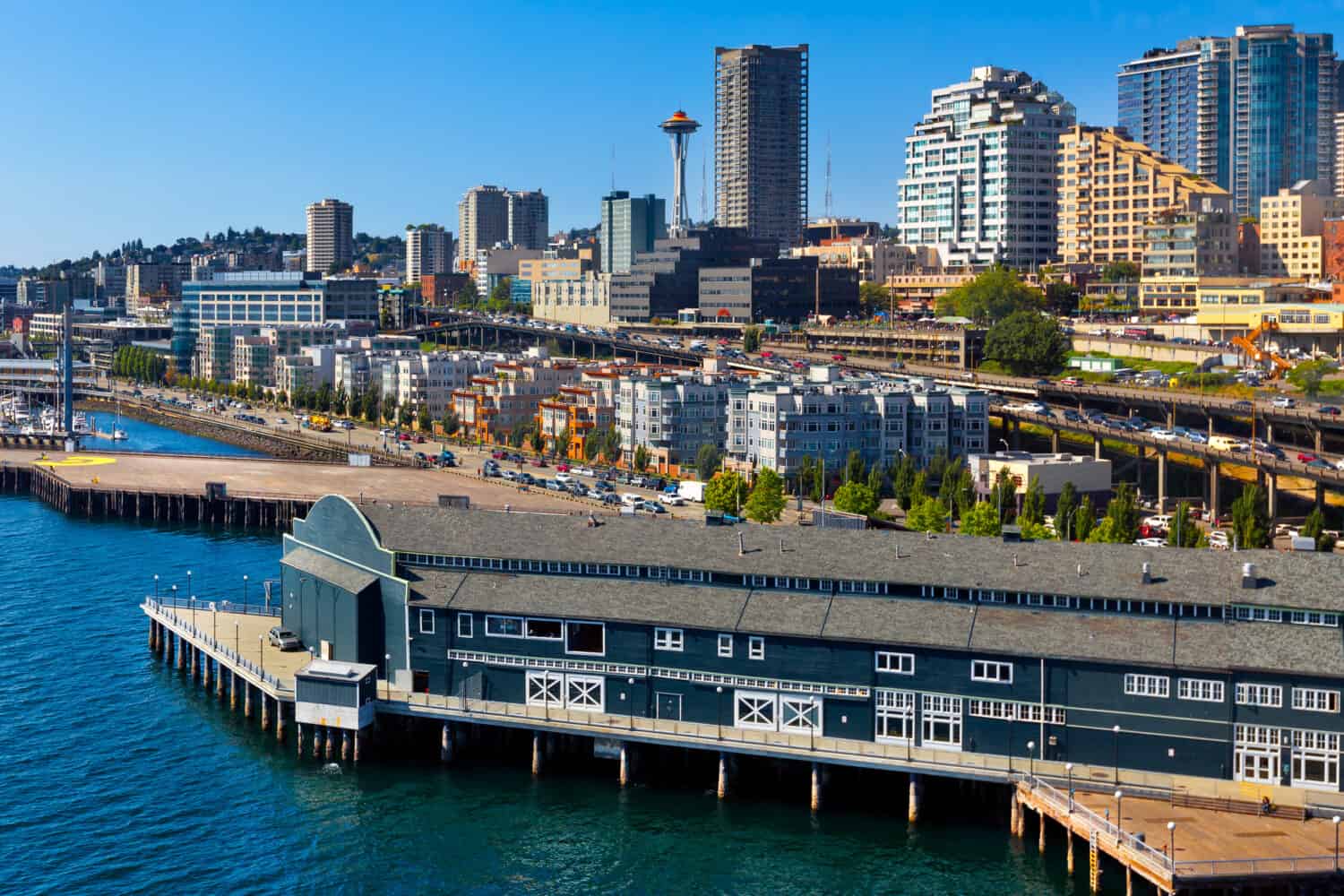The city of Seattle in Washington state often finds itself under a thick blanket of clouds, either shrouded in drizzle or in pouring rain. This is a familiar image to anyone who has heard of the city, which is why it has a reputation as one of the rainiest places in the United States. However, there’s more to Seattle’s rainy season than meets the eye.
Seattle’s rainy season is definitely a defining aspect of the city’s climate and culture. Visitors and residents have come to appreciate and, in some cases, endure the frequent showers that characterize this region.
The Timing of Seattle’s Rainy Season
Seattle’s rainy season typically extends from late fall through early spring. While it doesn’t rain every single day during this period, the region experiences a notable increase in precipitation, gray skies, and overcast conditions. There are different seasons even with the nearly perennial rains in Seattle, as seen below:
Late Fall (October – November)
The first signs of the rainy season usually appear in October. After a relatively dry and warm summer, the transition to fall results in a noticeable increase in rainfall. Therefore, October in Seattle can be characterized by sporadic rain showers as well as a gradual decrease in daylight hours.
Winter (December – February)
Even though it starts raining in October, the heart of Seattle’s rainy season falls during the winter months, from December through February. This period sees the most consistent and frequent rainfall. Low-pressure systems from the Pacific Ocean often sweep across the region, bringing moisture-laden air and precipitation. December is typically the wettest month of the year, with rain becoming a near-constant companion for Seattleites.

Seattle is the largest city in King County, Washington. It is also known for the heavy rains that it receives almost during the entire year.
©Pung/Shutterstock.com
Early Spring (March)
As spring approaches, the rainy season begins to wane, but March still sees its fair share of rainfall. However, the days gradually become longer, and there is a noticeable shift towards more sunshine and milder temperatures. By the end of March, Seattle is on the cusp of emerging from its rainy season.
Late Spring and Summer (April – September)
The arrival of April marks a significant shift in weather patterns. While Seattle can experience occasional showers in April and May, these months are known for blossoming cherry trees and the emergence of vibrant greenery. By the time summer arrives, typically in June, Seattle enjoys its driest and sunniest weather. This is when the city comes alive with outdoor festivals, hikes, and waterfront activities. There is hardly any rain during this time, and so it is the perfect time to visit the city, in case you don’t like the rain.
Why It Rains So Much in Seattle
To truly grasp why Seattle experiences such a prolonged and wet rainy season, we must understand the different climatic and topographical influences on the weather. Several key elements contribute to the city’s reputation as one of the rainiest places in the United States:
1. Geography: The Olympic Mountains and the Cascade Range
Seattle’s location on the western edge of Washington State places it between two significant mountain ranges: the Olympic Mountains to the west and the Cascade Range to the east. These mountains play a crucial role in the city’s weather patterns.
The prevailing westerly winds from the Pacific Ocean carry moist air masses toward the Pacific Northwest. As this moist air encounters the Olympic Mountains, it is forced to rise, cool, and condense, resulting in heavy rainfall on the western slopes of the mountains. Seattle is situated on the windward side of the Olympics, and receives significant rainfall as a result of this orographic lift.
To the east, the Cascade Range similarly influences Seattle’s weather. While the Cascades receive abundant precipitation on their western slopes, where Seattle is located, they create a rain shadow on their eastern side, contributing to the relatively drier conditions in central and eastern Washington.

An amazing panoramic aerial landscape view from Cle Elum, Washington, from a rest stop near I-90. It is about an hour east from Seattle, Washington.
©EnyoHouseStudio/Shutterstock.com
2. Puget Sound and Marine Influence
Seattle is also close to Puget Sound, which is a complex system of estuaries, bays, and inlets connected to the Pacific Ocean. Puget Sound’s presence amplifies the marine influence on Seattle’s climate.
During the rainy season, the marine air masses from the Pacific Ocean carry ample moisture. As these air masses move inland and encounter the cooler waters of Puget Sound, they become more unstable. This leads to increased cloud formation and precipitation. The marine influence also contributes to Seattle’s moderate temperatures, preventing extreme cold in winter and extreme heat in summer. Thus, Puget Sound makes Seattle even rainier.
3. Convergence Zone
One of the most unique meteorological phenomena affecting Seattle’s rainfall is the Puget Sound Convergence Zone. This is an area where two air masses collide and converge, causing a localized band of heavy precipitation. The convergence zone often forms near Seattle and can result in significant rainfall disparities between the northern and southern parts of the city. However, this zone can be highly variable and unpredictable, adding an element of mystery to Seattle’s weather patterns.

Seattle skylines and Interstate freeways converge with Elliott Bay and the waterfront background of in sunset time in Seattle, Washington State.
©Checubus/Shutterstock.com
4. Pacific High-Pressure Systems and Low-Pressure Systems
Seattle’s weather is also influenced by the movement of high-pressure and low-pressure systems in the Pacific Ocean. High-pressure systems, often referred to as the Pacific High, can bring periods of dry, sunny weather to the region, especially during the summer months.
Conversely, low-pressure systems are responsible for Seattle’s rainy season. These systems originate in the North Pacific and move eastward, directing moist air masses toward the Pacific Northwest. When these low-pressure systems interact with the topographic features, such as the mountains and Puget Sound, they produce the widespread and persistent rainfall characteristic of Seattle’s rainy season.
5. Seasonal Shifts in the Jet Stream
The position of the jet stream, a high-altitude, fast-moving air current, plays a crucial role in Seattle’s weather patterns. During the rainy season, the jet stream often dips southward, directing storm tracks toward the Pacific Northwest. This shift results in the frequent passage of weather fronts, bringing periods of rain, clouds, and cooler temperatures to the region.
Effect of Rains on Wildlife in Seattle
The rainy season in Seattle, with its increased precipitation and the transformation of the landscape, has a profound impact on the local wildlife. While the Pacific Northwest is known for its lush forests and diverse ecosystems, the rainy season brings about specific benefits as well as challenges for the region’s wildlife.

Penguins standing on a mound at the Woodland Park Zoo in Seattle.
©Chang Han Chris Kim/Shutterstock.com
Abundance of Water Sources
One of the most immediate effects of the rainy season on wildlife is the abundance of water sources. Ponds, streams, and rivers fill up, providing essential hydration and breeding grounds for various species. This influx of water helps aquatic habitats and supports amphibians, fish, and insects. Salmon, for example, take advantage of the increased water flow to migrate upstream for spawning, which is a remarkable natural spectacle of reproduction that draws wildlife enthusiasts from far and wide to the city.
Birds and mammals also benefit from the increase in water sources during the rainy season. The availability of clean water encourages a wider array of species to congregate in certain areas, which increases interactions and opportunities for breeding and foraging.
Foliage and Food Supply
Seattle’s rainy season contributes to the lushness of its landscapes. The increased precipitation nourishes plants and contributes to the growth of foliage, which, in turn, has a cascading effect on the local wildlife
This is because rainfall stimulates plant growth, leading to an abundance of vegetation in forests, wetlands, and meadows. This vegetation, therefore, becomes a critical food source for herbivores such as deer, elk, and rabbits.
The rainy season also encourages the growth and spread of insects, including mosquitoes, flies, and beetles. These insects are essential food sources for birds, bats, and various other insect-eating animals.
Many plant species in the Pacific Northwest produce fruits and nuts during the rainy season. These resources attract wildlife like bears, squirrels, and various bird species, which play a crucial role in dispersing seeds and maintaining the health of local ecosystems.

Spring blossoms line Lake Washington Boulevard in Seattle, Washington.
©GeorgeColePhoto/Shutterstock.com
Migration and Nesting
Seattle and its surrounding areas are part of important migratory routes for birds and other wildlife. The rainy season coincides with the fall and spring migrations of numerous species.
During the fall, many bird species, including waterfowl, shorebirds, and raptors, use the wetlands and water bodies created by the rainy season as stopover points on their way south. These areas provide crucial resting and foraging sites before continuing their journey.
In the spring, the return of migratory birds coincides with the breeding season for many resident species. The increased rainfall supports wetland habitats where waterfowl build nests, rear their young, and forage for aquatic plants and invertebrates.
Challenges for Wildlife
While the rainy season provides numerous benefits to Seattle’s wildlife, it also poses specific challenges.
Excessive rainfall can lead to flooding of habitats, which displaces wildlife and causes stress, particularly for species that nest close to water bodies. Some animals may have to adapt quickly or face the risk of losing their nests and their young.
Heavy rains can also lead to soil erosion, impacting aquatic ecosystems by increasing sedimentation in rivers and streams. This can affect fish populations by burying their spawning grounds and reducing water clarity.
In wetter conditions, disease transmission among wildlife can also increase. For example, standing water can act as breeding ground for disease-carrying insects, affecting both wildlife and human health.
Finally, the rainy season can bring wildlife closer to human settlements as animals search for food and shelter. This can lead to conflicts, especially with species like raccoons, which may scavenge in garbage cans and create nuisances.
Adaptations to Rainy Season

A view of Alki Beach in West Seattle, Washington on a windy day.
©Beach Creatives/Shutterstock.com
Seattle’s wildlife has evolved various adaptations to cope with the rainy season and its challenges. Many species have waterproof fur, feathers, or scales that help shed water, keeping them dry. Birds may build more sheltered nests, and some mammals hibernate or become more nocturnal to avoid the wettest parts of the day.
For migratory species, the timing of their migrations is often synchronized with the availability of food and nesting opportunities brought about by the rainy season. These adaptations ensure the survival of these species and contribute to the overall ecological balance.
Coping with Seattle’s Rainy Season
While Seattle’s rainy season has several benefits, it can also present challenges for residents and visitors. However, the city has embraced its reputation for rain and developed a unique culture that thrives despite the gray skies. Here are some ways in which Seattle copes with its rainy season:
1. Coffee Culture
Seattle’s coffee culture has become legendary, with numerous coffee shops and roasters dotting the cityscape. On rainy days, there’s nothing quite like seeking refuge in a cozy café with a warm cup of locally roasted coffee. Starbucks, one of the world’s most famous coffee chains, originated in Seattle and continues to be a beloved staple for caffeine enthusiasts.
2. Outdoor Enthusiasm
Seattleites are a resilient bunch when it comes to the weather. Many embrace the rainy season by continuing to pursue outdoor activities, such as hiking, biking, and jogging. The city’s parks and green spaces are well-used year-round, and rain gear is a staple in many wardrobes.
3. Cultural Offerings
Seattle also has a vibrant cultural scene, with world-class museums, theaters, and music venues. The rainy season also provides the perfect opportunity to explore these indoor attractions, from the iconic Experience Music Project (EMP) Museum to the Seattle Art Museum.

University of Washington, Seattle, Washington.
Cherry blossoms blooming
in the crowded garden.
©iStock.com/Joecho-16
4. Rain Attire
Seattle residents have perfected the art of dressing for the rain. High-quality rain jackets, waterproof boots, and stylish umbrellas are common sights on the city’s streets. The choice of rain attire is both practical and a form of self-expression.
5. Acceptance and Resilience
Perhaps the most significant coping mechanism for Seattle’s rainy season is a general acceptance of the weather. Locals understand that rain is part of the package, and they adapt accordingly. This resilience has fostered a unique sense of community among Seattleites, who often bond over shared experiences of rain-soaked commutes and soggy outdoor adventures.
Conclusion
In conclusion, Seattle’s rainy season is a defining feature of the city’s climate, culture, and identity. From late fall through early spring, the region experiences an increase in rain, gray skies, and overcast conditions. The interplay of geographical features, including mountain ranges, Puget Sound, and marine influences, coupled with meteorological factors like the jet stream and seasonal shifts, contribute to Seattle’s reputation as one of the rainiest places in the country.
However, despite the challenges posed by the rainy season, Seattle has embraced its wet reputation. Locals and visitors indulge in the city’s coffee culture, explore its cultural offerings, and continue to enjoy outdoor activities year-round. The acceptance and resilience of Seattleites in the face of persistent rainfall have helped shape the city’s unique character and sense of community. So, the next time you find yourself in Seattle during the rainy season, remember that there’s more to this city than just its weather — it is a place where rainy days can be just as enchanting and fun as sunny ones.
Thank you for reading! Have some feedback for us? Contact the AZ Animals editorial team.








